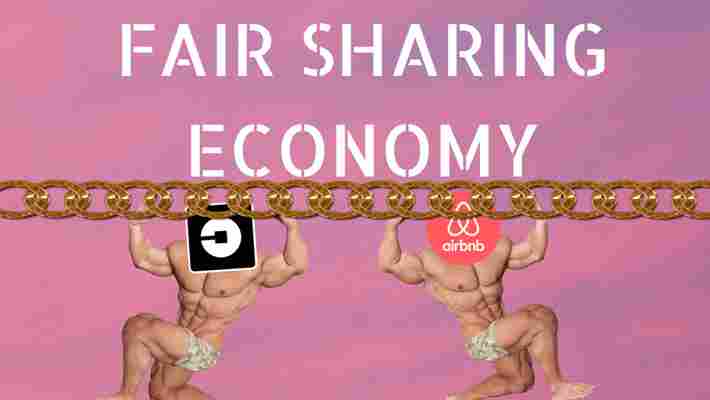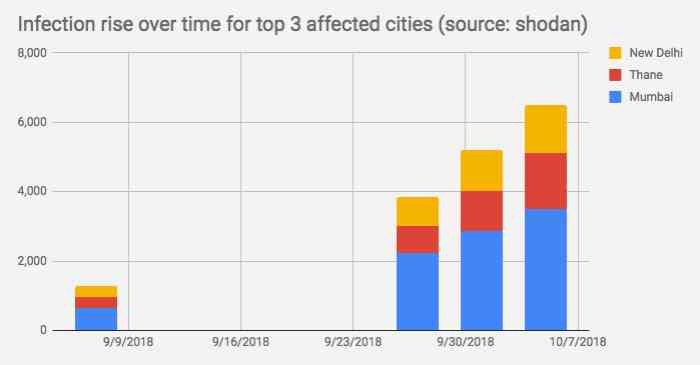Blockchain is the key to fair distribution of wealth in the sharing economy
Early sharing economy enthusiasts had a clear vision for the peer-to-peer marketplace: path towards sustainability, empowerment of individuals, and new job opportunities for the disadvantaged. However, the sharing economy’s giants such as Uber and Airbnb quickly overtook the marketplace, painting a vastly different picture.

While they provide convenience and efficiency, there’s a price to pay: low wages and job insecurity. As a result, we’ve seen a number of workers across the globe take it to the streets to voice their dissatisfaction with unfair work practices .
And these workers are not just talking the talk; they’ve also started walking it. A number of them united to start or join platform cooperatives — platforms owned and governed by the workers, users, or both. While these platforms aim to reinvent Uber and Airbnb by using cooperative principles, they are struggling to get on the radar of consumers. But blockchain is coming to the rescue.
It’s promising to make trust, reputation, and coordination possible without the need for centralized authority. So I wonder, how would the sharing economy world look if it was run by the users, for the users?
This is how Uber and Airbnb create and capture value
The so-called “sharing economy,” pioneered by platforms such as Uber and Airbnb, is a marketplace for exchange of goods and services powered by digital technologies. Platforms bet their fortunes on people’s willingness to share their cars, homes, and even dogs with complete strangers. And it’s paying off. Uber, valued at $48 billion , is currently the second most valued tech startup in the world (behind Didi).
The way platforms earn their money is by connecting individuals to one another. In other words, their competitive advantage lies in their ability to exploit network effects. Meaning, the more users they have on one side of the platform, the more attractive is the platform for users on the other side.
For instance, the more Uber drivers join the platform, the more is the platform attractive for the passengers, and the other way around. Therefore, workers and users are at the core of value creation.
The value created by workers and users on these platforms is, however, captured by the platforms that facilitate transactions. The platforms are going even further to tap into communities and leverage individuals’ skills and talents. Airbnb recently launched “Experiences,” so for every tour guide a person offers or a cooking class he gives, Airbnb takes a 20 percent cut . Airbnb also decides which “experiences” are appropriate. Therefore, platforms not only capture a big chunk of the generated value, they also make decisions that affect communities.
Blockchain is promising to level the playing field. If in right hands, it could enable individuals to transact directly with one another without the need for centralized authority, while promising the same, if not superior, security levels. In addition, profits could go back to the community that generated them.
Sounds like a distant dream, doesn’t it? But it’s actually not that far from becoming a reality.
The rise of platform cooperatives
Cooperatives existed since the 19 th century and in the long-run, they proved to be more successful and resilient to economic crises. Despite this, they’ve never become mainstream. But the sharing economy has given cooperatives a chance to be reborn, this time as platform cooperatives. While they offer alike services to Uber, Airbnb, TaskRabbit, and Bla Bla car, they differ in ideology.
Up&Go , currently operating in New York is a platform cooperative version of a popular platform Helpling . It connects house cleaners to customers. Workers realized that if they unite, they can make their own decisions and capture all the profits. Partago , a cooperative version of Bla bla car , offers car sharing of electric vehicles. Community members can also get together, purchase an electric vehicle, share it with other communities and get returns on the investment, while a small portion goes back to the cooperative for administrative purposes.
Despite cooperatives’ good intentions, they have difficulty of acquiring venture capital, which prohibits them from being an early-entrant and leveraging network effects that made Uber and Airbnb rise to the fame. In addition, cooperatives struggle with efficient decision making and they still need to facilitate trust like other platforms. But blockchain is promising to provide exactly that, giving platform cooperatives a needed push.
Blockchain can enable true sharing
Blockchain is probably one of the most radical technologies today. Some prescribe the existence of institutions themselves to the cost of transactions. Blockchain is making those transactions practically costless, shaking the very foundations of capitalism. While this technology has many advantages, as well as flaws, in the case of sharing economy, it can be an extremely valuable asset.
This is how blockchain can assist platform cooperatives:
Facilitation of trust
Blockchain can make trusting one another possible without the need for centralized authority. Members of the cooperative can define a set of rules that would be enforced by smart contracts.
For instance, members can decide that each new member must be trusted by at least three other members in the network. Smart contracts would then insure this condition is met.
Insurance
This idea of “distributed trust” could be carried onto insurance. Each existing member would need to place a monetary value on the trust of a new member.
If the new member does not deliver a desired service (clean rental apartment), the members that vouched for him would take a hit. This could reduce free-riding and create a community that enforces trust and cooperation.
Review system
With centralized systems such as Airbnb, t he platform decides which reviews are to be shown . With the blockchain, on the contrary, once something is written, it stays there forever.
One company is offering blockhain-mediated reputation technology specifically to platform cooperatives. Individuals are evaluated across different dimensions and their reputation is transparent and portable across different communities.
Decision making
Cooperatives have historically struggled to organize efficiently. Blockchain could make decision making easier than ever. Members of the cooperative, all over the world, could digitally vote for various issues. Blockchain ensures that each member stays anonymous and that the system cannot be hacked. One startup has already developed digital ballot boxes .
Profit sharing
Finally, generated profits could be shared among the members of the cooperative. Blockchain could record each member’s contribution to the platform and compensate the person accordingly.
Blockchain technology is far from perfect and platform cooperatives have a long way to go to be seen as real competitors of platforms like Uber and Airbnb. But the times are changing and if people are already comfortable with sharing their personal goods and offering services to complete strangers, the day may come when they will unconditionally trust one another and engage in collaborative ownership, with one word doing the magic: blockchain.
This decentralized Reddit copycat lets you buy upvotes with Bitcoin
ThunderMessage is a decentralized take on Reddit powered by Bitcoin‘s Lightning Network – and it’s already full of shitposts.

Just like in Reddit, users can post messages, and then upvote and downvote them. But this message board is different – instead of clicks, you have to send small amount of Bitcoin for each upvote or downvote. One Satoshi (a Satoshi is 0.00000001 BTC), one upvote (or downvote).
What results is really a great demonstration of the decentralized nature of the blockchain – but also feels strangely metaphoric to the state of cryptocurrencies in general. It is totally devoid of censorship, runs completely on libertarian ideals, and the more Bitcoin you have – the more your vote counts.
Here’s how it works: users who have a Bitcoin wallet compatible with the Lightning Network are able to post messages. If you want your new message to start off with just one vote, then just send one Satoshi.
But if you really want your new message to rank, you send more Satoshis. Similarly, if you’d rather a message crushed into the ground, add some more Bitcoin to your downvote and it might never be seen again.
In this world, one Satoshi really does equal one like (or dislike). This particular post, though, is set to be backed by ThunderMessage’s upper-limit. It would cost 0.04294967 BTC to post – approximately $350.
Users then scan the QR-code based invoice using their smartphone wallet, which signs the transaction. The post will go live once has been confirmed. Luckily, confirmation times on the Lightning Network are quite quick at the moment, so the messages go through pretty much in real-time.
The whole experiment is pretty new, ThunderMessage has really only been around for just over a week. Already, though, it has turned into a war of Satoshis between Bitcoin Cash evangelists and the new Lightning kids on the block. It should be noted, that this entire platform is running on the Lightning Network – making any anti-Lightning Network posts almost lethally ironic.
Time for some quick maths: collectively Bitcoin Cash shills have spent 0.00055 BTC to have their message appear so high up on the front page. That’s around $4.50, and that’s not even counting the weight of its downvotes – meaning it’s real value could be somewhere in the ballpark of $8.50.
Just how far the shills will got to astroturf a platform like ThunderMessage, though, is another question. For now, it’s definitely just fun to put a monetary value on good ol’ fashioned shitposting like this, however small:
There is a similar service running that aims to filter quality online merchants and real-world stores that are compatible with the Lightning Network. That service might actually prove somewhat useful, and less prone to spam – so if that’s more your thing – head to Lightning Network Stores and do some shopping on the blockchain.
We also recently reported on an actual online graffiti board that runs on Lightning Network too – that one was promptly over-run with pictures of dicks, proving that there are way too many disposable Satoshis out there.
Crypto-jacking epidemic spreads to 30K routers across India
The spate of crypto-jacking plaguing the internet shows no sign of slowing down. After infesting hundreds of thousands of routers in Brasil with cryptocurrency mining malware, reports indicate hackers have compromized a further 30,000 routers across India.

As Hard Fork previously reported, black-hat hackers are waging a war on the internet . Attackers have already forced almost 280,000 MicroTik routers in Latin America to mine Monero (XMR) non-stop, so the discovery of the malware running on routers elsewhere is nothing but troubling.
“The number of compromised routers [in India] has doubled in the past month,” wrote internet security unit Banbreach. “ For the top three cities with the most infected routers, the growth has been [500 percent].”


Worryingly, it appears internet service providers (ISPs) in India are distributing infected routers, presumably unaware hackers have rigged them to mine Monero on every page passing through their networks.
“I found [CoinHive] in the router provided by my ISP a couple of days ago,” tweeted a security enthusiast from Mumbai. “Probably all the routers used by them are infected and outdated.”
Crypto-jackers favorite tool is CoinHive
CoinHive is a supposedly neutral piece of code enabling browsers to mine cryptocurrency, particularly the anonymity-focused altcoin Monero.
It’s best to think of CoinHive as a tool; charities use it to raise funds indirectly, but here, internet baddies are using it to steal the computing power of unsuspecting users to mine cryptocurrency for themselves.
To complicate matters, hackers are also intensifying efforts by rapidly sharing new, modified versions of their malware in a bid to spread it as quickly as possible.
Data shared by McAfee Labs shows more than two and a half million different versions of crypto-jacking malware (most of it CoinHive related) have been issued in the past three months.
Crypto-jacking succeeds in non-metro areas
Security researchers, like Banbreach and fellow malware-tracking group Bad Packets Report, use powerful search engines to listen to internet traffic. Services like Google only show websites, but those are only a small part of picture.
These detect all the devices on the internet with public IP addresses. As routers fall into that category, it is possible to snoop on some of the traffic passing through them.
Some of the publicly available data relates to its source location. This allows for the mapping of internet traffic.
Researchers grouped populated areas of India into three tiers. One contains the most dense, metropolitan areas, with two and three increasingly remote.
The chart below shows a great disparity in infection rates. Note, there are far more infected routers running in remote areas than in cities; 45 percent of the infected routers in India are in the most rural areas.
Banbreach explained that cybersecurity awareness is “much, much lower in the ‘non-metro’ areas” of India.
To give an understanding of the scope of CoinHive, related studies suggest the total output of all the machines running CoinHive scripts generates more than $250,000 in XMR every month – although remember, not all of it comes by way of crypto-jacking.
If it helps – the hackers are primarily exploiting vulnerabilities in MicroTik brand routers. If you have one, refer to the manufacturer for an official patch.
As well, here is a handy guide on how to best protect your browser against crypto-jackers.
If you’re interested in everything blockchain, chances are you’ll love Hard Fork Decentralized. Our blockchain and cryptocurrency event is coming up soon – join us to hear from experts about the industry’s future. Ticket sales are now open, check it out!

Leave a Comment